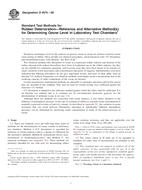Potrebujeme váš súhlas na využitie jednotlivých dát, aby sa vám okrem iného mohli ukazovať informácie týkajúce sa vašich záujmov. Súhlas udelíte kliknutím na tlačidlo „OK“.
ASTM D4575-09
Standard Test Methods for Rubber Deterioration-Reference and Alternative Method(s) for Determining Ozone Level in Laboratory Test Chambers
Automaticky preložený názov:
Štandardné skúšobné metódy pre gumy zhoršenie-referencie a iná metóda (y) pre stanovenie ozónu v laboratóriu Skúšobné komory
NORMA vydaná dňa 1.7.2009
Informácie o norme:
Označenie normy: ASTM D4575-09
Poznámka: NEPLATNÁ
Dátum vydania normy: 1.7.2009
Kód tovaru: NS-27761
Počet strán: 10
Približná hmotnosť: 30 g (0.07 libier)
Krajina: Americká technická norma
Kategória: Technické normy ASTM
Anotácia textu normy ASTM D4575-09 :
Keywords:
chemical, deterioration, ozone measurement, rubber test, ultraviolet, Absorption methods, Calibration--rubber analysis instrumentation, Chemiluminescence detection, Deterioration--rubber, Electrochemical measurements/testing, Modified spray-jet device, Ozone (O3) cracking, Reference testing methods, Rotameter applications/analysis, Rubber (ozone cracking), Single column absorption, Spray-jet device, Ultraviolet (UV) analysis--rubber, Wet chemical analysis, ICS Number Code 83.060 (Rubber)
Doplňujúce informácie
| Significance and Use | ||||||||||||
|
General purpose and many specialty rubbers will undergo ozone cracking when exposed to ozone containing atmospheres, when the test specimens or actual use products are under a certain degree of tensile strain. Certain additives such as antiozonants and waxes inhibit or prevent this cracking. Various rubbers and rubber formulations containing such additives are customarily evaluated under static or dynamic tensile strain in laboratory ozone chambers. This standard provides for an accurate assessment of the ozone content of such chambers used in Test Methods D 518, D 1149, D 1171, D 3395 and ISO Standard 1431 I/II/III. For additional information on ozone analysis, refer to Code of Federal Regulations; Title 40 Parts 1 to 51. |
||||||||||||
| 1. Scope | ||||||||||||
|
1.1 These test methods cover the following three types of methods for the determination of ozone content in laboratory test chambers. Method A (UV absorption) is specified for reference or referee purposes and as a means of calibration for the alternative methods; Method B, instrumental device (electrochemical or chemiluminescence); and Method C, wet chemical techniques (see Appendix X1). These methods are primarily intended for use with tests for determining rubber ozone cracking resistance and thus are applicable over the ozone level range from 25 to 200 mPa. Note 1—Prior to 1978, ozone concentrations were expressed in ASTM D11 Standards in parts per hundred million (pphm) of air by volume. See Appendix X2 for an explanation of the change to partial pressure in millipascals (mPa). 1.2 The values stated in SI units are to be regarded as standard. No other units of measurement are included in this standard. 1.3 This standard does not purport to address all of the safety concerns, if any, associated with its use. It is the responsibility of the user of this standard to establish appropriate safety and health practices and determine the applicability of regulatory limitations prior to use. For a specific hazard statement, see Note 2 and 5.1. Note 2—Warning—Ozone is a hazardous chemical. |
||||||||||||
| 2. Referenced Documents | ||||||||||||
|




 Cookies
Cookies
